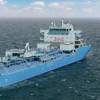First Russian LNG Cargo Journeys to Japan
The first Russian LNG cargo for delivery to Japan has been successfully loaded from the Sakhalin II LNG plant into the Energy Frontier LNG carrier. The Energy Frontier left the Prigorodnoye port on 29 March for the Sodegaura terminal in Tokyo Bay, with a cargo of some 145 thousand cubic metres of LNG intended for two of the Company's foundation customers - Tokyo Gas and Tokyo Electric. The LNG was loaded through the 805-metre long jetty at the Prigorodnoye port, which was purpose built for the year-round export of liquefied natural gas (LNG) and oil.
"This is a key milestone, the culmination of many years of effort by the Russian federation, the Sakhalin Oblast, our shareholders and the thousands of company and contractor staff who made it all possible," said Sakhalin Energy's CEO Ian Craig. "Russia has marked its entry into the Asia Pacific LNG market and Japan has a new long term energy partner."
With the start of LNG production and off-loading and year-round oil deliveries, which began in December 2008, a new major Asian energy source is now on stream. Today Sakhalin LNG is produced at train 1 with train 2 scheduled to come on stream later this year. This year and 2010 will see a gradual ramp-up to full production capacity. The newly built Sakhalin II infrastructure includes three offshore platforms, an onshore processing facility, 300 km of offshore pipelines and 1,600 kilometres of onshore pipelines, an oil export facility and the LNG plant.
Practically all of the 9.6 million tonnes of annual production capacity of the LNG trains 1 and 2 has already been committed in long-term contracts to supply customers in Japan, Korea and other markets. Sakhalin LNG is the first Russian gas supplied to these regions and the establishment of the new export route confirms the country's status of a global energy power.
With the start of LNG production from Sakhalin II, Shell now has interests in LNG operations in six countries, covering both the Atlantic and Pacific basins. The Sakhalin II LNG plant has been designed using Shell's innovative liquefaction technology taking maximum advantage of the outside ambient temperature, resulting in high efficiency and low CO2 emissions. Sakhalin II increases Shell's global LNG production capacity by almost 17% and reinforces our leadership position in LNG among international oil companies. In addition, the access we have to LNG volumes from Sakhalin II enhances our global LNG marketing capability.













